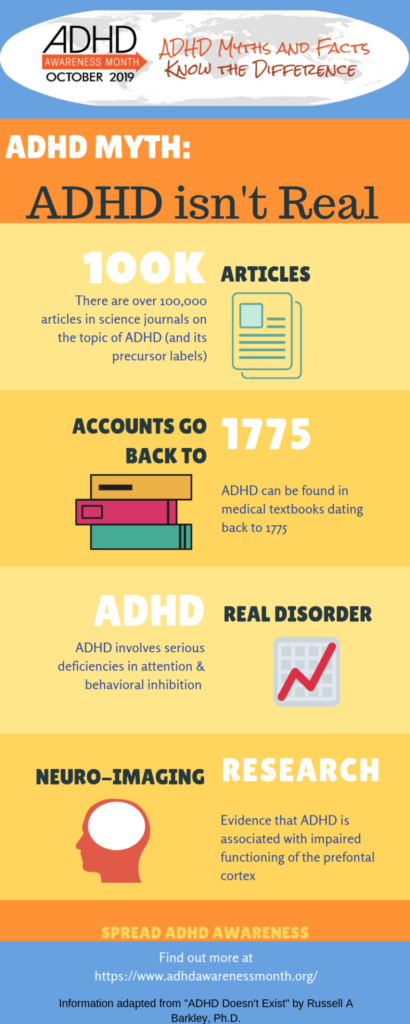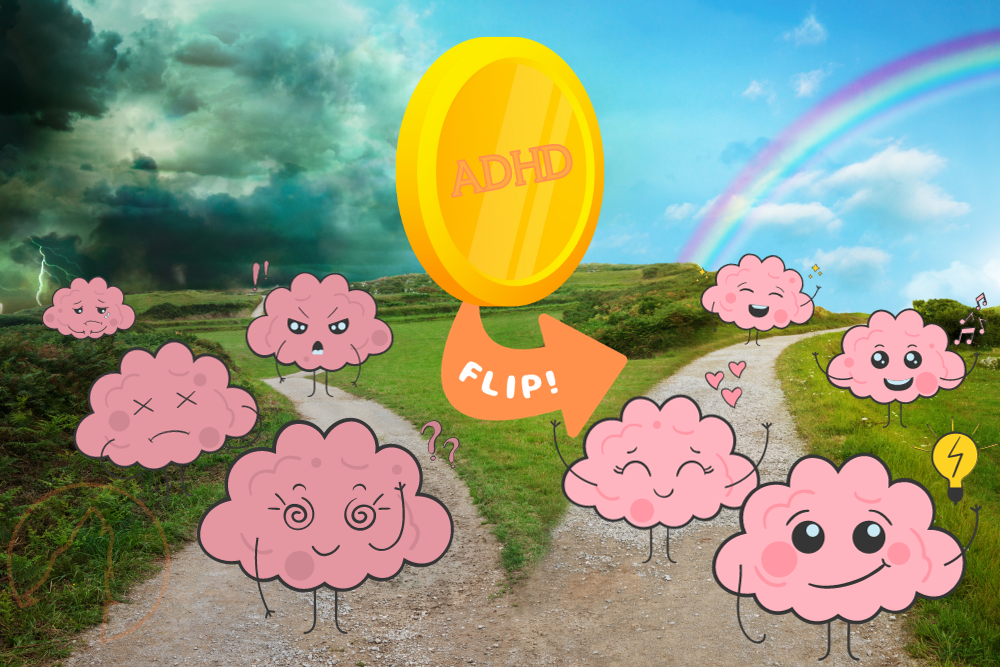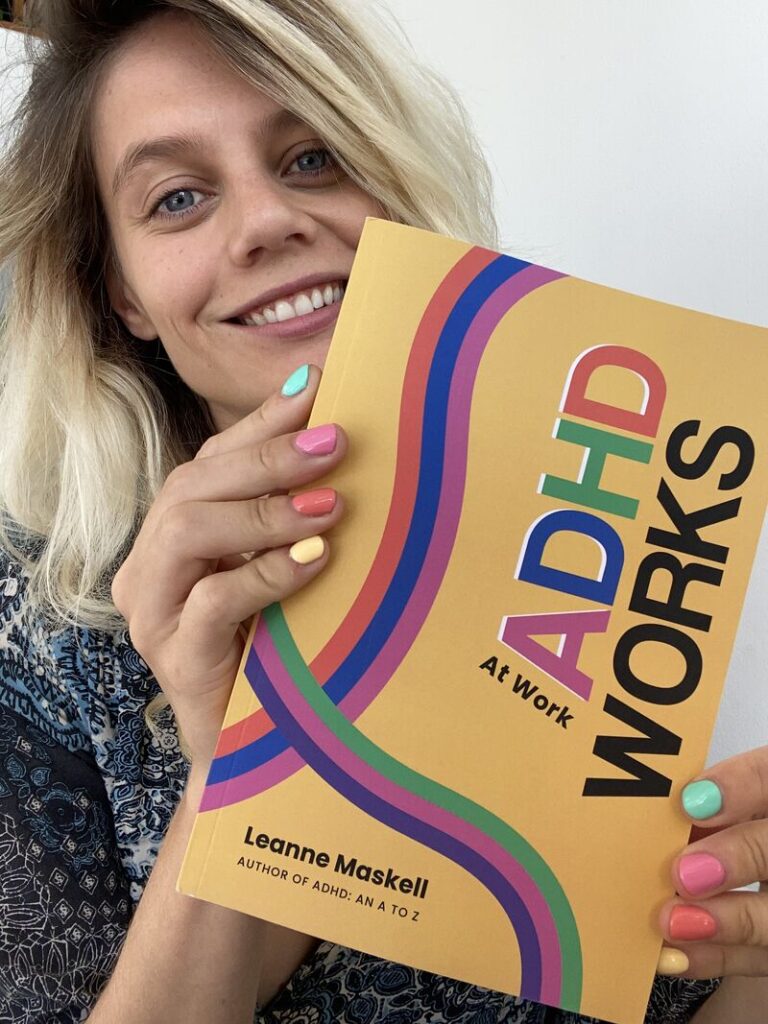The crispity crunch of auburn leaves underfoot, the scent of pumpkin-spice-everything offerings, the cool breezes blowing in a reprieve from the heat of summer… autumn is here, and October brings the best of it.
Yet, October is more than just the time when trees become autumn-speckled and seasonal flavors emerge – it’s also National Disability Employment Awareness Month (NDEAM) and ADHD Awareness Month, to name a couple observations.
As we strive to champion DEIB (Diversity, Equity, Inclusion, and Belonging) in a thoughtful, intelligent, and fair way, it’s essential for us at Fullmoon Digital to shed light on the nuances surrounding employment for those with ADHD and how the broader umbrella of disability can shape workplace experiences.
Not only that, but we are ADHD. At least, some of us (like me) experience daily life with this type of mental wiring. But I’ll just speak for myself, representing the pack here and the ADHD community at large.

Table of Contents
ADHD is Made Up (+ Other Myths)
Oh, I wish it were! 
FACT: There are more than 100,000 articles in science journals on ADHD and references to it in medical textbooks going back to 1775.

A few other unfounded myths:
ADHD is overdiagnosed.
But, it isn’t. It does seem to have spiked, the number of diagnoses seemingly have shot into the stratosphere faster than a rocket. But the truth is, rates with which ADHD is diagnosed vary so much as the diagnostic criteria and measurement methods used are still being developed. We are just now learning more about it than ever before. Just because we don’t understand something, doesn’t mean it doesn’t exist.
ADHD is just an excuse for laziness.
This is one that I was gaslit into believing about myself before I came to know that ADHD is actually a result of chemical dynamics of the brain and a lot of the actions, behaviors and thought patterns aren’t under voluntary control.
Everyone has a little ADHD.
So, while you or someone you know may have behaviors that you call out as “ADD moments,” this is not the same as truly living with ADHD. This is because not everyone has a physical difference in their brain that influences those behaviors.
However, it’s true that everyone exhibits some behaviors like the symptoms of ADHD. While anyone can be forgetful and distracted sometimes (especially with our shortening attention span thanks to info burst-style social media, poor nutrition habits, and stressors that are a symptom of our fast-paced society). It’s also true that the vast majority of people – around 90-95% – do NOT have ADHD.
Losing your wallet, zoning out during a Zoom call, showing up late, and impulse control happens to everyone at points in life, yet these behaviors are not the same as having ADHD. We’re human, and such experiences are human behaviors that occur for a variety of reasons. With ADHD, the reason is neurological in origin. The structure, volume, chemical activity and communication pathways of ADHD brains diverge from those without it and has been linked to genetics.
All children grow out of having ADHD.
Again, I wish! Some children do recover from their disorder by age 21 or 27. For a significant number of folks who experience ADHD (50-86%), bothersome symptoms and impairments persist beyond childhood.
Another reason that the number of people you know getting diagnosed with ADHD is because adult ADHD symptoms may not be as clear as those in children. Hyperactivity may be decreased, yet struggles with impulsiveness, restlessness and difficulty paying attention may continue.
ADHD is a Chronic Lifelong Syndrome
What does this mean, exactly? Well, for one is for many: ADHD is mental road black, detour and potholes of the otherwise smooth operation of self-regulatory functions within the brain.

The ADHD behaviors experienced result from this inner dysregulation and manifest in forgetfulness, distractibility, impulsivity and an inability to focus. Additionally, emotional dysregulation, executive dysfunction, disorganization, poor time management, excessive restlessness, low frustration tolerance, follow-through, and insufficient stress coping are other lesser-known symptoms for untreated persons.
It’s no wonder that for people with ADHD, these behaviors are disruptive. And they happen more frequently, with greater intensity and severity than for people without ADHD. When you don’t have the tools or the understanding of those around you, this is overwhelming, exhausting and demoralizing.
What adds to this frustration is that when people with ADHD try to change on their own without the right tools, support or knowledge, the course-correction that works for others just doesn’t stick. And when that’s the case, the consequences are life-impacting: We earn less and accrue more debt. We wrestle with academic and professional performance. We even face increased risk of physical injury.
When to See a Doctor
If any of the symptoms listed in this blog continually disrupt your life, it may be time to talk to your doctor about the possibilities of having ADHD.
Note: Different types of health care professionals may diagnose and supervise treatment for ADHD. Specifically seek a provider who has training and experience in caring for adults with ADHD.
Flipping the ADHD Coin
But it’s not all bad. ADHD minds like mine also come with some pretty sweet perks.

For example, we tend to be chatty folks, able to spark up a fun conversation in just about any setting. I (sometimes) love that my mouth moves faster than my brain! Plus, my creativity is always churning. I can come up with solutions or angles that elude others, and as a writer, my content is enticing and full of character and zesty flavor.
Our emotional sensitivity is heightened too. I feel things deeply and can pick up on others’ subtle cues. This makes me a caring, empathetic friend and an observant, helpful coworker. Yes, even working remotely, I find myself tuned into often otherwise missed nuances.
And don’t even get me started on my ability to hyperfocus! Like writing this blog. I meant to take a break for lunch a few hours ago, and shame on me, I just was too dern into this topic to stop writing and researching! When I’m dialed into a project I love, I’m unstoppable. The outside world fades away and I can puzzle over problems for hours.
Some studies show ADHD minds are stronger in social intelligence, humor, and thinking outside the box. We tend to be curious, energetic folks with a passion for life. Maybe I’m a little biased, but I think that’s pretty cool.
So while ADHD certainly comes with challenges, we should give credit to the gifts of it, too. Honestly, despite my struggles from day 1 in 1987 to today, I love my ADHD. My neuro-wiring may be different, but it makes me, well, me! And I wouldn’t trade it for the world.
I would, however, recommend learning how to harness this unicorn disorder so you can ride the rainbow skies like never before. With the right support and coping strategies, we can nurture our strengths while managing the rough patches both at home and at work. The more we learn to embrace all kinds of minds, the more we’ll see our “weaknesses” as moldable opportunities!
There’s an App for That
Speaking of the right kind of support and resources… Very recently, I’ve been seeing commercials for apps that are specifically designed for helping adults with ADHD to learn coping skills and strategies that cater to these neurological abnormalities called Effecto.
Pulling the deets straight from the App Store,
“Effecto is a health tracking app that reveals how your actions affect your health, mood, and symptoms. Then it shows you exactly how your actions correlate with each other and what impact they have over time. Do this for a few weeks, and you’ll know exactly what to do and what to avoid to improve your physical and mental health – for good.”
I just took the quiz the other day before I knew I was going to write this blog, and they aren’t sponsoring this pitch. But I’m excited to try this out! (Once I remember to finish signing up, that is… 
More like this – Other coping skills and apps: https://www.additudemag.com/dealing-with-adhd-80-coping-strategies/
ADHD Works at Work: A Game-Changer
When it comes to having ADHD in the workplace, knowledge is power.
Y’all, I am so excited for this! A significant resource I’ve come across is Leanne Maskell’s book “ADHD Works at Work,” released just this past week on October 3rd. Leanne, a bestselling author and certified ADHD coach, aims to change employers’ perspectives on employees who, in her words, “think differently.”

The essence of Maskell’s book revolves around several key points:
- Breaking the Stigma: Maskell addresses the internalized feelings of many with ADHD—those who feel out of place, misunderstood, or unsupported in their employment journey.
- Rights Awareness: It’s one thing to have rights, but another to understand and exercise them. Maskell breaks these down in ways that are accessible to all, ensuring no one is left in the dark about what they’re entitled to.
- A Wealth of Experience: Maskell’s background in disability law and work with major corporations such as Microsoft, Disney, and Bank of America places her in a unique position to provide insights from both legal and corporate perspectives.
With endorsements from major figures in the neurodiversity space and features in notable publications including Reader’s Digest and HuffPost, “ADHD Works at Work” is poised to be an indispensable resource for both employers and employees.
Don’t trip over one another as you rush to get this book! It’s available both in hard copy and on Kindle as well, which is extra great for Amazon Prime subscribers.
Beyond the Month: A Continuous Commitment to Inclusivity
Let’s shift back to the overarching theme of NDEAM to wrap up this piece by talking about one of my favorite “influencers,” Emily Ladau.


Emily Ladau is a renowned Jewish Disability Rights Activist, author, digital communications consultant, and all-around storyteller. Her career jump started early by appearing on Sesame Street at age 10 to help educate children about life with a physical disability. Ever since, she has made disability advocacy her life’s work.
Co-hosting The Accessible Stall podcast and authoring “Demystifying Disability: What to Know, What to Say, and How to be an Ally” isn’t all she does. She is also a proud Reform Jew who works with the URJ as a consultant to promote a culture of inclusion around disability, and then some.
On LinkedIn, Ladau recently articulated the dichotomy of NDEAM in a poignant way. While the intent behind such a month is laudable, she prompts us to question its necessity. Shouldn’t an inclusive employment landscape be the norm rather than a yearly highlight?
Ladau’s reflections serve as a clarion call for all organizations:
- Data vs. Humanity: While data-driven evidence of inclusivity is crucial, it’s essential to remember that behind every percentage point is an individual – a person with aspirations, challenges, and experiences.
- Authentic Storytelling: Sharing success stories can be a powerful testament to inclusivity, but it’s paramount to ensure these narratives aren’t reduced to mere tokens of diversity.
- Year-round Action: DEIB isn’t a month-long initiative. If companies spotlight disabled employees or share data, it should be part of a larger strategy to foster inclusivity throughout the year.
Ladau’s shirt, emblazoned with the words “Not your diversity statistic,” further encapsulates this sentiment. It’s a visual reminder that individuals with disabilities are not mere numbers or PR tools – we’re people deserving of respect, understanding, and genuine inclusivity.
Neuro-Challenged? More Like Neuro-Spicy!
As I reflect on both ADHD Awareness Month and National Disability Employment Awareness Month, it’s clear there’s still work to be done in creating truly inclusive workplaces. Resources like Leanne Maskell’s book give us some stellar insights, and perspectives like Emily Ladau’s keep those introspection skills flexing.
But fostering inclusivity can’t just be a one-month deal. To create truly inclusive workplaces, we need to keep chipping away at it year-round. As someone cruising through life on the ADHD express, I know first hand: inclusive workplaces don’t just happen. They’re created through consistent, thoughtful choices guided by respect, compassion and belief in the dignity of every person.
The metrics matter, but we can’t forget the humans behind the stats. When we build workplaces where people can thrive as their truest selves, there truly is a special kind of magic!
The opportunity is ours if we’re willing to take it. I know the road can get bumpy, but with understanding, empathy and advocacy, we can ride the rapids of neurodivergence together. You need tones of every hue and saturation to make up the complete color wheel, after all.



